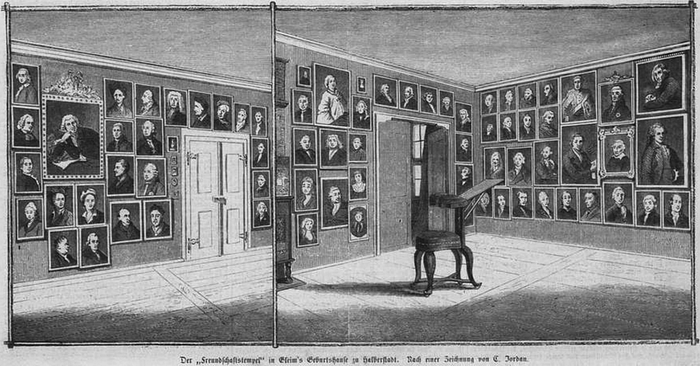Insights on User Experience from an 18th Century Poet
Written on
The Birth of Social Networking: Gleim's Temple of Friendship
In the year 1747, Johann Wilhelm Ludwig Gleim, a young German poet, found himself surrounded by an abundance of correspondence from friends and acquaintances in his Halberstadt study. This moment sparked a realization: while he had exchanged countless letters, many of these individuals remained strangers to him in person. This insight led him to ponder a way to visualize his relationships, culminating in the creation of his "Temple of Friendship."
Gleim began to curate painted portraits of his friends and family, transforming his apartment into a vibrant gallery that showcased these connections. This remarkable collection was positioned with his own portrait at the center, symbolizing his role within this social network. Thus, Gleim's Temple of Friendship can be seen as an early form of social media, highlighting the importance of relationship representation.
The Art of Curation in Social Networks
Gleim's approach to assembling his portrait gallery was a meticulous process of curation. He ensured that the displayed portraits reflected the dynamics of his social circle over time. This practice parallels how individuals curate their online personas today on various social media platforms, selecting what to share and how to present themselves. His habit of rearranging the portraits based on the closeness of friendships resonates with modern features like "friend circles" or "follower counts."
In his quest for connection, Gleim even commissioned a custom chair with a built-in table, allowing him to sit in front of any portrait and address the person as if they were there. This inventive solution provided a sense of presence, reminiscent of today's virtual meetings on platforms like Zoom.
The Continuous Need for Connection
Gleim's Temple of Friendship serves as a poignant reminder of humanity's enduring need for relational expression. While he utilized physical portraits in the 18th century, we now harness the capabilities of social media to fulfill this age-old desire. Other intellectuals of that era kept track of their networks through personal friendship journals known as the Album Amicorum, while later forms of correspondence and friendship tokens served similar purposes.
This raises an intriguing question: is the expression of our social connections a fundamental human need that transcends time and technology? Or was Gleim simply an innovative individual ahead of his time?
The Evolution of User Needs
Despite the technological advancements separating Gleim's time from today, the essence of human connection remains unchanged. The desire to establish relationships, curate our self-image, and express social ties is as relevant now as it was then. While Gleim's Temple was a private affair, today's social media profiles are public, requiring careful consideration of how we present ourselves.
Gleim's physical gallery contrasts with our digital profiles, yet both represent our relationships and influence our interactions with others. This highlights the significance of understanding fundamental user needs that persist across different eras.
Three Core User Needs
Gleim's experience is a reminder that the expression of our relationships is vital. As social beings, we inherently seek connection. Technological transformations may occur, but the desire for community and self-presentation remains constant.
- Greed: The timeless pursuit of wealth and status has driven human behavior throughout history. From financial bubbles to the quest for fame, the allure of easy gain remains a constant theme.
- Desire for Connection: Throughout history, humans have sought physical and emotional connections. From traditional courtship practices to modern dating apps, the means of fulfilling these desires continue to evolve.
- Entertainment Needs: The pursuit of captivating experiences is a fundamental aspect of human nature. Whether through ancient games or contemporary social media platforms, the craving for distraction and enjoyment persists.
Understanding these core user needs enables the creation of meaningful products and services. As aspiring entrepreneurs and UX leaders, starting with these foundational elements can foster true innovation.
Adapting to Technological Shifts
As technology evolves, so do the paradigms of social interaction. The emergence of platforms like MySpace, Facebook, Instagram, BeReal, and TikTok illustrates the shifting landscape of how we share and consume information. Each new innovation builds upon existing needs while offering novel ways to connect.
However, the resistance to change is common. Once a paradigm is established, adapting to new ideas can be challenging. Embracing change while remaining grounded in fundamental user needs is crucial for success in the ever-evolving technological landscape.
In conclusion, the insights gained from Gleim's Temple of Friendship can guide our understanding of user experience today. By recognizing the core human needs that have persisted through time, we can innovate and create products that resonate with people's lives.
